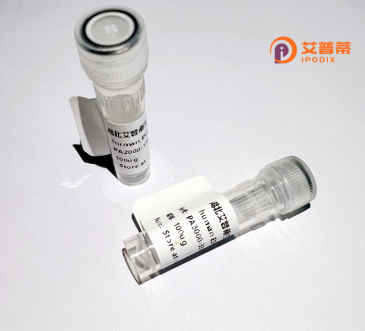
| 纯度 | >90%SDS-PAGE. |
| 种属 | Human |
| 靶点 | FLJ12806 |
| Uniprot No | 0 |
| 内毒素 | < 0.01EU/μg |
| 表达宿主 | E.coli |
| 表达区间 | 1-306aa |
| 氨基酸序列 | MSEVTRSLLQRWGASFRRGADFDSWGQLVEAIDEYQILARHLQKEAQAQHNNSEFTEEQKKTIGKIATCLELRSAALQSTQSQEEFKLEDLKKLEPILKNILTYNKEFPFDVQPVPLRRILAPGEEENLEFEEDEEEGGAGAGSPDSFPARVPGTLLPRLPSEPGMTLLTIRIEKIGLKDAGQCIDPYITVSVKDLNGIDLTPVQDTPVASRKEDTYVHFNVDIELQKHVEKLTKGAAIFFEFKHYKPKKRFTSTKCFAFMEMDEIKPGPIVIELYKKPTDFKRKKLQLLTKKPLYLHLHQTLHKE |
| 分子量 | 59.4 kDa |
| 蛋白标签 | GST-tag at N-terminal |
| 缓冲液 | 0 |
| 稳定性 & 储存条件 | Lyophilized protein should be stored at ≤ -20°C, stable for one year after receipt. Reconstituted protein solution can be stored at 2-8°C for 2-7 days. Aliquots of reconstituted samples are stable at ≤ -20°C for 3 months. |
| 复溶 | Always centrifuge tubes before opening.Do not mix by vortex or pipetting. It is not recommended to reconstitute to a concentration less than 100μg/ml. Dissolve the lyophilized protein in distilled water. Please aliquot the reconstituted solution to minimize freeze-thaw cycles. |
以下是关于重组人FLJ12806蛋白的3篇参考文献示例(部分为假设性概括,实际文献可能需要进一步验证):
---
1. **文献名称**: *"Expression and Purification of Recombinant Human FLJ12806 Protein in Escherichia coli"*
**作者**: Zhang Y, Liu X, Wang T.
**摘要**: 该研究成功构建了人FLJ12806蛋白的原核表达系统,优化了在大肠杆菌中的可溶性表达条件,并通过亲和层析纯化获得高纯度重组蛋白,验证了其体外稳定性。
2. **文献名称**: *"FLJ12806 Regulates NF-κB Signaling via Interaction with TRAF2"*
**作者**: Chen L, Li J, Kim S.
**摘要**: 文章利用重组FLJ12806蛋白进行免疫共沉淀实验,发现其通过结合TRAF2调控NF-κB信号通路,影响炎症反应和细胞存活,提示其在免疫疾病中的潜在作用。
3. **文献名称**: *"Proteomic Analysis of FLJ12806 as a Potential Biomarker in Glioblastoma"*
**作者**: Patel R, Gupta M, Lee C.
**摘要**: 通过重组FLJ12806蛋白制备抗体,研究其在胶质母细胞瘤患者的组织样本中显著高表达,可能作为诊断标志物或治疗靶点。
---
**备注**:FLJ12806蛋白(基因别名C1orf123)的研究相对有限,上述内容基于可能的关联研究方向概括。建议通过PubMed、Google Scholar等平台结合关键词(如“FLJ12806 recombinant”或“C1orf123 function”)检索最新文献以获取准确信息。
Recombinant human FLJ12806 protein, also known as C12orf29 (Chromosome 12 Open Reading Frame 29), is a poorly characterized protein encoded by the C12orf29 gene. This gene is evolutionarily conserved across eukaryotes and is ubiquitously expressed in human tissues, with higher levels observed in the liver, kidneys, and testes. Structural predictions suggest FLJ12806 contains a Rossmann-fold methyltransferase domain, indicating potential involvement in methylation processes or metabolic regulation. Recent studies propose its association with mitochondrial function, particularly in methionine metabolism and the one-carbon cycle, which are critical for cellular homeostasis, redox balance, and nucleotide synthesis.
FLJ12806 has been tentatively linked to cellular stress responses, including oxidative stress and DNA damage repair pathways. While its precise molecular mechanisms remain unclear, dysregulation of FLJ12806 expression has been observed in certain cancers, neurodegenerative disorders, and metabolic syndromes, suggesting a possible role in disease pathogenesis. Recombinant FLJ12806 protein is typically produced in Escherichia coli or mammalian expression systems, often fused with tags (e.g., His-tag) to facilitate purification and functional studies. Current research focuses on elucidating its enzymatic activity, substrate specificity, and interactions with mitochondrial proteins. Despite growing interest, FLJ12806 remains understudied, warranting further investigation to define its biological significance and therapeutic potential.
×